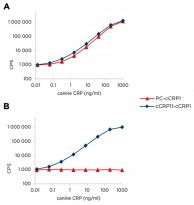ARG10642
anti-C Reactive Protein antibody [cCRP11]
anti-C Reactive Protein antibody [cCRP11] for ELISA,FLISA,Sandwich ELISA and Dog
Overview
| Product Description | Mouse Monoclonal antibody [cCRP11] recognizes C Reactive Protein |
|---|---|
| Tested Reactivity | Dog |
| Tested Application | ELISA, FLISA, sELISA |
| Host | Mouse |
| Clonality | Monoclonal |
| Clone | cCRP11 |
| Isotype | IgG1 |
| Target Name | C Reactive Protein |
| Antigen Species | Dog |
| Immunogen | Dog C-reactive protein (whole molecule). |
| Conjugation | Un-conjugated |
| Alternate Names | PTX1; C-reactive protein |
Application Instructions
| Application Suggestion |
|
||||||||
|---|---|---|---|---|---|---|---|---|---|
| Application Note | * The dilutions indicate recommended starting dilutions and the optimal dilutions or concentrations should be determined by the scientist. |
Properties
| Form | Liquid |
|---|---|
| Purification | Purification with Protein A. |
| Buffer | PBS (pH 7.4) and 0.09% Sodium azide. |
| Preservative | 0.09% Sodium azide |
| Storage Instruction | For continuous use, store undiluted antibody at 2-8°C for up to a week. For long-term storage, aliquot and store at -20°C or below. Storage in frost free freezers is not recommended. Avoid repeated freeze/thaw cycles. Suggest spin the vial prior to opening. The antibody solution should be gently mixed before use. |
| Note | For laboratory research only, not for drug, diagnostic or other use. |
Bioinformation
| Gene Symbol | CRP |
|---|---|
| Gene Full Name | C-reactive protein, pentraxin-related |
| Background | The protein encoded by this gene belongs to the pentaxin family. It is involved in several host defense related functions based on its ability to recognize foreign pathogens and damaged cells of the host and to initiate their elimination by interacting with humoral and cellular effector systems in the blood. Consequently, the level of this protein in plasma increases greatly during acute phase response to tissue injury, infection, or other inflammatory stimuli. [provided by RefSeq, Sep 2009] |
| Function | Displays several functions associated with host defense: it promotes agglutination, bacterial capsular swelling, phagocytosis and complement fixation through its calcium-dependent binding to phosphorylcholine. Can interact with DNA and histones and may scavenge nuclear material released from damaged circulating cells. [UniProt] |
| Calculated MW | 25 kDa |
Images (2) Click the Picture to Zoom In
-
ARG10642 anti-C Reactive Protein antibody [cCRP11] FLISA image
FLISA: Calibration curve of native cCRP in a sandwich fluoroimmunoassay. ARG10642 anti-C Reactive Protein antibody [cCRP11] and Eu3+ -labeled ARG10641 anti-C Reactive Protein antibody [cCRP1] were used as capture and detection antibodies respectively.
-
ARG10642 anti-C Reactive Protein antibody [cCRP11] sELISA image
Sandwich ELISA: Comparison of PC and ARG10642 anti-C Reactive Protein antibody [cCRP11] as capture molecules in the presence (A) or absence (B) of Ca2+ . PC was conjugated to BSA. Native cCRP was used as the antigen and Eu3+ labelled ARG10641 anti-C Reactive Protein antibody [cCRP1] as the detection antibody. The assay buffer was supplemented with 2 mM Ca2+ (A) or 5 mM EDTA (B).







